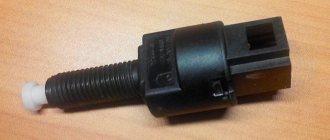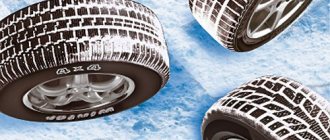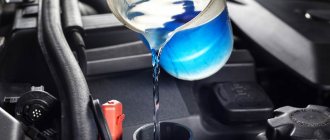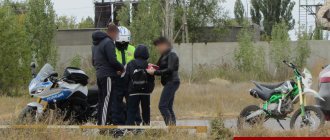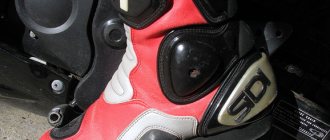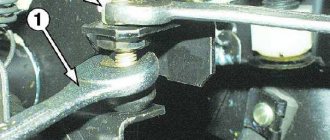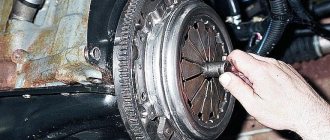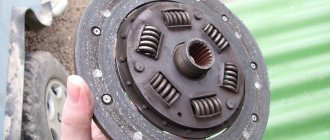How to start with a manual transmission
Day three and you already know how to brake in case something goes wrong.
Wonderful. Let's move on to studying the question of how to get started on the mechanics. To do this, we need to learn how to operate the gas pedal. The exercise is quite simple. Get behind the wheel and place your right foot on the gas pedal. Now you smoothly press the gas and try to understand the relationship between the force you press on the gas pedal and the engine speed. Naturally, the car is on the handbrake, the gear is off, and the left leg is simply resting. We played around with the gas pedal a little, and now we move on to combat exercises. You guess the number of revolutions from 1000 to 2500 and try to catch and maintain this value of revolutions. If the car is not equipped with a speed sensor (tachometer), you will have to navigate by the sound: “A little loud, medium volume, oh, how loud.” Our goal is to increase the speed to increase engine strength (torque). It’s better, of course, to learn in a car with a tachometer. We have guessed 2200 rpm, and are trying to catch this value on the device. As soon as we catch it, we release the gas pedal and try to catch this value right away. As soon as you start to succeed, we learn to get under way. This is where you will definitely need a second person, preferably an experienced driver, who will at least provide you with a handbrake.
We take the car off the handbrake, depress the clutch, engage first gear and make the engine run at 2200 rpm. Then you will select the optimal speed yourself, and you won’t even notice how you start moving. We smoothly release the clutch pedal until that very moment, after which we begin to control the cleanliness of the engine. If the engine is heavy and the car begins to shake, press the clutch pedal a little and let the car pick up speed. As you gain speed, release the clutch pedal all the way in a smooth motion. At the same time, press the gas pedal. As soon as the clutch pedal is fully released, depress the clutch and brake. After stopping completely, keep your right foot on the brake, engage neutral gear, then engage reverse gear, and repeat the starting process exactly. Just keep in mind that reverse gear is often stronger than first gear, so you need to add a little less gas.
If you consider this exercise in accelerated mode, you should get something like “Start - Stop - Start - Stop.” The task is to move off as quickly as possible (in time, not in speed) and at the same time smoothly. It only took my wife 40 minutes to learn how to operate the clutch pedal, brake and start. Of course, for the first time we cannot count on professional starting and braking, but this gives us the opportunity to hone an already acquired skill. Once you are able to start and brake, get out of the car and walk around a little. Repeat the exercise and leave the machine to rest.
The next day, your task is to learn how to move away without jerking or spinning the wheels, so that you yourself enjoy sitting in the car. In the same way, you need to learn to brake. As a result, you must learn to move on a reflex level, without resorting to the help of your eyes and brain. Ideally, in the future, you should have such control over the clutch and gas pedals that you can hold the car motionless on an upward slope. Yes, this is not useful for the clutch, but it shows quite well how well you have learned to interact with these two pedals.
Good luck on the roads!
Braking in extreme weather conditions
Being able to slow down and stop on dry road surfaces with a manual or automatic transmission is not the most important thing. It is much more difficult for a novice driver to prevent skidding or skidding. The most important thing is to learn how to brake your car correctly in cold weather on slippery road surfaces.
How do you need to brake with a manual transmission and at the same time prevent skidding and skidding in icy conditions? First of all, you need to drive the car more calmly than in the summer on good and not wet asphalt.
On a wet or icy road or in snow, due to poor adhesion of the car wheel surface to the road surface, the braking distance increases several times.
Even if you have foreseen the worsening weather conditions and “changed” your car into winter “shoes”, be more careful, drive your car more smoothly, and start braking in advance. Remember: driving in the summer and in the cold season are two completely different styles of driving your car.
Use engine braking to properly stop a manual transmission on icy road surfaces. This method can be used not only in icy conditions. But first, let's understand what engine braking is and why it should only be used in limited driving situations.
How to avoid burning your clutch
How not to burn out the clutch when starting from a standstill
How to change gears correctly on a manual transmission
Let's get straight to the point. Your engine is running. Neutral gear engaged. In order not to burn out the clutch, you press the pedal and go into first gear. The main thing is to make a smooth connection between the crankshaft and the gearbox.
Attention! In the section, everything will happen as follows: the driven disk will be pressed against the rotating one. In this case, the number of revolutions will be about 25 per second.
In order not to burn the system when moving from neutral to first gear, we divide the operation into three stages:
- Press the pedal lightly. At this moment, the springs on the pressure plate will bring the second disk to the flywheel. The touch will be light and weightless. Thanks to this, the car will move. Of course, the speed will be minimal.
- In the second stage, you need to hold the clutch pedal for no more than 2-3 seconds. This will equalize the rotation speeds of the disk and the flywheel. The car will begin to gradually accelerate.
- Now the car drives confidently on the road. The torque is completely transferred to the transmission. You can release the pedal. You don't need to hold it for too long. This will burn the disks.
Follow this algorithm when driving away. It will allow you not to burn out the clutch in the first thousand.
The nuances of starting from a place
To avoid burning out the clutch and crashing into the nearest tree, before starting to drive, be sure to check whether the car is on the handbrake. Before you start driving, it doesn't hurt to warm up the engine a little.
When you press the pedal all the way down and engage first gear, be sure to turn on the turn signal if necessary. Otherwise, you risk causing an accident.
To avoid burning the system, bring the pedal exactly to the moment of setting. At the same time, you can increase the pressure on the gas. The number of revolutions on the tachometer will jump to one and a half thousand revolutions.
Important! You should not raise the speed to 2500-3000. It could burn out the clutch
When starting, constantly monitor the position of the tachometer needle. Unfortunately, many drivers try to monitor engine performance by relying solely on their ears. But this is not the best option, since the accuracy of such monitoring is not very high.
At first, it will be very difficult for you to correctly calculate the force with which you need to press the gas pedal. Therefore, for a while, give up shoes with hard soles. You will also have to forget about heels.
How to avoid burning out your clutch at a traffic light
In most cases, huge damage to the system is caused due to incorrect actions when driving through intersections with traffic lights. The fact is that in many driving schools, instructors give incorrect information in advance. They say that in order not to burn out the clutch at a traffic light, it is enough to depress the pedal and leave first gear engaged.
At first glance, a fit like this can actually help prevent the clutch from burning out. But in reality, everything happens a little differently. Indeed, the disks do not touch in this mode. Accordingly, the linings should not burn. But with such operation, the load on the release valve increases. As a result, it becomes several times easier to burn the part.
Attention! At a traffic light, in order not to burn out the clutch, go to neutral and release the pedal.
How to avoid burning your clutch in traffic
This component of the transmission suffers a lot of damage when the car is parked in a traffic jam. The fact is that many drivers simply do not take their foot off the pedal, turning the crankshaft connection to the gearbox on and off.
Because of this, the driven disk rubs against the flywheel. The main problem is that the movements are asynchronous. As a result, increased heating occurs, and it becomes easier than ever to burn out the entire system.
Attention! When you get stuck in a traffic jam, cover the distance in stages, shifting into gear without touching the clutch pedal
What is a car clutch
Structurally, the clutch (friction clutch) in a car is designed to connect/disconnect the engine shaft with an automatic or manual transmission. This allows you to move away without sudden jerks and ensures smooth gear shifting on the move, preventing overload of the transmission components due to changes in the crankshaft speed. There are different drive designs for transmitting force from the pedal to the pressing mechanisms, such as mechanical, hydraulic and electric.
Where is
Since the purpose of the clutch is to transmit torque from the engine crankshaft to the gearbox, it is structurally located between these two units. The specific location may depend on the layout of the base units, front-wheel drive or rear-wheel drive transmission, but in any case it will be at the front of the car under the hood.
- Carbon dioxide fire extinguisher - device, how to activate and rules of use
- Why do you need a Spikes sign - dimensions according to GOST, where to stick it in a car according to traffic rules and a fine for failure
- How to determine a person's location by phone number online
Device
Being a connecting unit for transmitting rotation, the design of a friction clutch in a car is not particularly complicated. The main components are:
- Pressure disk - has release springs at the base and is designed to connect to the flywheel. Due to its petal design, it received the title “basket” for its similarity in appearance.
- The driven disk has a coupling, a radial base and linings. Special damper springs help reduce shaking when switching.
- Release bearing - located on the input shaft and drives the drive fork. Some designs may use locking springs for a more secure fit.
- Clutch pedal - with the help of it, the driver from the cabin controls the work process, transmitting instructions to connect or disconnect the engine drive shaft and gearbox. In cars with an automatic transmission (automatic transmission) there is no pedal; the system operates using a special servo drive.
Modern car manufacturers offer customers different design options for friction clutches. Differences may include:
- number of disks - single or multi-disk systems;
- work environments – dry or wet options;
- drive - mechanical, hydraulic, electrical methods;
- method of pressing the pressure disk - clutch with a central diaphragm or springs in a circle.
What is it for?
It's very simple to understand how a car's clutch works - while the pedal is not pressed, the drive and driven disks are in contact, transmitting torque from the engine flywheel to the gearbox, and then through the driveshaft to the wheels. Pressing disconnects the discs, the rotation stops being transmitted, and the driver can change the speed
Then you need to slowly lower the pressure so as not to burn the friction clutch if the discs contact too sharply, and it is very important not to hold the pedal down for too long
The principle of operation of the flywheel Does it make sense to install a lightweight one?
How to learn to ride a motorcycle
Welcome! The flywheel is one of the important parts of the car, which must be carefully cared for in terms of driving, because if you drive carelessly (start with slipping, engage gears without squeezing the clutch, etc.), then the flywheel and the clutch itself will not last long long life and as a result will wear out greatly and require replacement.
Why does the flywheel wear out over time? How does this part actually work? And which flywheel is better to put on your car to make the car go faster? In fact, I get asked these three questions very often, so today we will look at them in more detail!
What causes flywheel wear?
If we talk about standard flywheels, then this happens only due to heavy loads on it, namely, as mentioned earlier, when starting abruptly, accompanied by slipping, as well as when the flywheel is installed incorrectly and when driving at high engine speeds, that is when the tachometer needle is in the red zone.
What is the operating principle of the flywheel?
The flywheel is the disc itself that transfers power from the engine to the clutch, then to the gearbox, and ultimately to the wheels, causing the car to move. When this unit operates, pendulum movements occur, namely, the flywheel does not rotate along its entire axis, but only works in one place according to the principle of a pendulum; for clarity, take a look at the figure below and you will understand everything.
Note! You can understand in more detail the principle of operation of this unit at the very bottom of the article, in the section called: “Additional video clip”!
Which flywheel is best to put on a car?
At the moment there are a lot of rumors that if you put a lightweight flywheel on a car, the car will supposedly go faster. In fact, everything is true, but unfortunately not in all cases. A lightweight version of this unit should be installed on a car only if the idle and running speed of the engine is intended only for medium speeds of “1700-∞”.
Therefore, if a lightweight flywheel is placed on a completely standard engine, the idle speed of which is “800 rpm”, then in this case, when starting the engine cold, the car will most likely operate unstably and may even stall. There is only one way out of this situation: raise the idle speed of the car through various modifications to the engine, or replace the flywheel with an old one.
Note! On a lightweight flywheel, try to never bring the engine operating torque to too low speeds when driving, because this will eventually destroy your engine from overloads!
How to replace the flywheel on a VAZ?
How to make a replacement - on the classics?
Additional video: For more details about the principle of operation of the flywheel, as well as its lightweight version, see the interesting video below:
Vaz-Russia.ru
How to drive a car with a manual transmission correctly? 5 Key Aspects of Management
The current trend in the car market is smoothly moving towards the transition to vehicles with an automatic transmission, but the bulk of cars are still manual. This type of transmission has its own advantages, including the possibility of complete integration with the car and improved cross-country ability. Until now, even in driving schools, training begins with manual transmissions, so the question that becomes relevant for beginners is how to drive a manual transmission correctly and what nuances you need to know about?
Often, due to ignorance of the intricacies of operating manual cars, beginners find themselves in unpleasant situations on the road, cannot start for a long time or suddenly stall at a traffic light, which causes disapproving exclamations from drivers driving behind them. Dissatisfied drivers honk their horns furiously, causing the newcomer to become even more stunned and lost. To prevent such situations from arising, it is enough to thoroughly study how to drive a manual car correctly and bring all actions to automaticity.
Why is the clutch burning?
Reasons why the brake pedal fails
The first and most common reason why the clutch burns is increased load on the car. What is meant by this concept? First of all, this is an aggressive driving style. Due to frequent and sudden starts from a standstill, the clutch disc spins and burns out. When driving in higher gears, the torque is not as significant, and therefore the risk of disc burning is minimized. As statistics show, it is during sharp starts from first gear that the clutch burns.
But it is not only an aggressive manner that can lead to such problems. For example, let's take the GAZelle car. It would seem that this truck is unlikely to be used for aggressive driving. But there is another problem: overload. It is because of overload that the load on the clutch and other components increases. The driver, in an attempt to move off, applies gas, or increases engine speed. Accordingly, the torque also increases. This moment is too large, and therefore the disk begins to partially scroll when it comes into contact with the flywheel.
The situation is similar with cars that tow a trailer. If the latter is significantly loaded, there is a high risk of burning the clutch. Of course, during rare trips it is impossible to completely wear out the disk, but its service life will definitely decrease.
Another situation that can lead to slipping (and, accordingly, burning) of the disk is towing another car. According to traffic regulations, the weight of the first vehicle must be higher or at least not less than the one being towed. Otherwise, the clutch suffers increased wear and sometimes burns badly. Similar cases occur during winter operation. A striking example is the car stuck in the snow. While trying to get going, the driver burns the clutch, unaware of the consequences.
Advantages and disadvantages
Since many drivers still prefer to drive a manual transmission, it is worth considering the key features and advantages of this transmission, namely, why they are still in such high demand. A manual transmission refers to a type of transmission that involves activating the necessary gears manually by the driver, taking into account the specifics of further actions, as well as current driving conditions. That is, the mechanics are intended to manually determine the direction and adjust the speed range.
In addition to the rear and neutral, there are from 4 to 7 stages, and the key feature is, in fact, the presence of a clutch, and the automation is limited only to the gas and brake pedal. It is by pressing the appropriate pedal that it becomes possible to switch speed modes.
Vehicles with manual transmission have the following undeniable advantages, which are noted by many drivers during operation:
- increased efficiency, higher dynamics;
- cross-country ability has been significantly improved;
- the ability to start the unit “from a pusher”;
- Vehicle towing is available at any distance;
- the range of riding variations is more diverse;
- high level of reliability;
- ease of maintenance;
- repair work is not that expensive.
Since not everyone likes to drive a car with a manual transmission, it is not without its drawbacks, so we will have to consider this side of the coin:
- the use of higher or lower speeds for movement leads to a decrease in the resource of the power unit;
- illiterate handling of the clutch and errors in gear shifting lead to an increased likelihood of failure of the gearbox itself;
- the constant need to control the position of the clutch pedal and switch speed modes leads to increased driver fatigue, especially when it comes to traveling long distances;
- It is quite difficult for beginners to understand changing gears and bring this process to automaticity.
What to replace
Many motorists are wondering what to change. A burnt clutch cannot be restored or repaired. Therefore, a completely new driven disk is installed on the car. In addition, experts recommend inspecting the condition of the pressure plate. If the petals are bent, this element must also be replaced. In addition, the release bearing needs to be replaced. Its resource is slightly higher than that of the disk. But if you take the box apart, then install a new bearing. Otherwise, you will have to disassemble the transmission again, after 10-20 thousand kilometers. And this procedure is quite labor-intensive and painstaking.
So, we have found out the signs of a burnt clutch and the causes of this phenomenon.
Sometimes, although rarely, this happens: you press the gas, “the engine roars,” as the famous song says, but the car doesn’t move. Or it goes, but slowly. The specialist will immediately say: “The clutch is dead,” and he will be right, but being right does not make it any easier, but even harder - after all, there will be expenses to replace it (the clutch).
When the clutch, or more precisely, the driven clutch disc, dies a natural death, when it has lived its allotted life, then this is normal. You can consider the clutch a consumable item. But sometimes it also happens that the owner of the car, through his actions, shortens the already not very long life of the driven disk, or even simply “kills” it.
First, let's talk about what this clutch is: it is a sandwich, where a driven disk made of a special material with a high coefficient of friction is clamped with terrible force between two metal drive disks. While this most terrible force of the clamping springs compresses the disks, then, provided that the driven disk is not worn out and has sufficient thickness, they can be considered a single whole. But as soon as you press the pedal, that is, “squeeze the clutch,” this whole sandwich ceases to be a single whole. The engine is spinning, the car is standing still - the driven disk is in place, and the two metal disks surrounding it are rotating along with the crankshaft, and you calmly engage first gear. You can’t drop the clutch - any motorist knows this from the time he studied at a driving school. You need to move off smoothly, and this smoothness is achieved by the fact that the middle driven disk slips for some time when the clutch is engaged, which leads to intense heating of the clutch and wear of the disks.
If the car is overloaded, then the process of moving away takes much longer than usual. At the same time, to prevent the engine from stalling, you have to slip the clutch for a long time, which leads to its accelerated wear and premature death. Some of my friends, having loaded almost a ton onto a passenger car, which, even though the car was a station wagon, was clearly too much, burned out the clutch on one trip to Kamensk. The same thing happens when the handbrake is pulled up.
A worn clutch fails very quickly - it slips a little, but this “slight” is enough for the entire assembly to heat up, then begin to burn, this causes the clutch to slip even more, the temperature rises - a vicious circle, but it turns out. The result is smoke, the smell of a burnt Ferodo, the engine is running, but the car is not moving.
Another option to easily burn out the clutch is to drive an ordinary modern high-speed passenger car into impassable mud. You will have to keep the speed high so that the engine pulls out, and at these high speeds you will have to actively slip the clutch so that the engine pulls out again. It’s the Niva that has a low gear in the transfer case, which you can use not only to drive out from anywhere, but also to plow your garden, but you still shouldn’t get into the mud with a regular car.
And one more thing: you shouldn’t stand at traffic lights waiting for the green light with first gear engaged and the clutch depressed. Of course, now that release bearings are widespread to replace outdated graphite thrust bearings, this is not so relevant, but a bearing under such a heavy load as a clutch also wears out quite a bit. You can, of course, drive without a clutch - engage first gear and start on the fly, then change gears at the moment you release the gas (synchronizers in the gearbox were clearly invented for this). However, there is little pleasure from such a ride, and it does not add health to the car. So take care of the clutch, it’s a necessary thing.
How to use the clutch correctly - how it works, how to depress the clutch and release the pedal
How to drive a car correctly and how to press the control pedals correctly is taught in driving schools, but it happens that even many years of driving experience do not teach you to take care of the clutch in the car - it simply wears out quickly and requires replacement (and without a clutch, until it is replace the car, it won’t be able to drive)
In order to understand how to properly use a car clutch, you need to have a good idea of how it works and the purpose of individual components, for example, the pressure plate, which motorists have long dubbed the “basket.”
Gas
What do you think, where should you start starting a car? Do you immediately press the gas and then engage the clutch, or vice versa? Have you thought about it? Then let's solve a simpler problem first. You have to carry a sack of potatoes from the field home on your back, and the distance to home is two kilometers! Was it worth eating in the morning? I think it was worth it, but not to overeat, but to eat normally so that you have strength.
And the same with the car!
Before loading the engine with the work of moving the mass of the car, it must be fed. The engine “eats” gasoline, and the “feeding” is controlled by the right foot on the gas pedal. Therefore, the first thing you need to do when starting the car is to press the gas. By the way, a little later you will be called to do the same by rice. 17,a and 18,a.
So, gas pedal. The heel of the right foot and everything else above it should remain practically motionless. Only the foot works! With a slight movement of the top of the foot, lightly press the gas pedal until you feel and realize... one and a half thousand revolutions of the engine crankshaft per minute!
So much for you! We started with a bag of potatoes and ended with an intricate phrase. Believe me, a good driver must understand all the components of the science of driving a car. And it’s not just working with the steering wheel and pedals. You need to know the rules of the road, the basics of road safety and the structure of the car (at least the principle of operation)! Moreover, you need to master these subjects not to successfully pass an exam, not “for your uncle,” but for yourself personally, for your future safe life on the road.
And at the moment you need to understand what “gas” means at one and a half thousand revolutions of the engine crankshaft.
Fig.14 Tachometer
On the instrument panel of half of the cars produced there is a device called a tachometer. This device shows the engine speed. Or a little simpler - how fast the engine shaft is spinning now. There is another way - how much the engine is “fed”. One way or another, the result of pressing the gas pedal is reflected on the device (Fig. 14).
As long as you did not press the pedal, the engine idled. This corresponded to the tachometer reading: 9-10, that is, 900-1000 rpm. For a confident start of the car, the engine should be “fed” to 1500-1800 rpm. On the tachometer this is expressed by the reading: 15-18.
I'm not sure that those who didn't have a tachometer in their car were out of luck. Although they did not have to use trial and error to determine these speeds by ear.
On the one hand, they were, of course, unlucky - there was nowhere to look and therefore they needed a hint from an assistant. And at the same time, they were clearly lucky, since they learned to determine the rotation frequency of the engine crankshaft by sound and vibration.
I want to warn those who have a tachometer in their car. Don't get used to it! Learn to hear and feel the engine running. The driver does not have the right to constantly be distracted from the road while looking at the readings of numerous instruments. After practicing a little with eyes open and closed, listening to the engine work. You will very quickly learn how to make any “gas” without the help of any instruments.
And now, in one way or another, you need to make 1500-1800 rpm pleasant to the ear and get ready to operate the clutch pedal.
What to do if the brakes fail
- Warn other drivers! Signal and turn on your hazard lights
- At low speeds, it makes sense to use the handbrake. We press the button and smoothly lift the lever, while paying attention to the clicks, and do not allow sudden braking and blocking of the car wheels.
- Is handbrake braking impossible for some reason? Brake the engine! In critical conditions, it is necessary to turn off the ignition and turn on first gear. In this case, a breakdown of the gearbox or engine is guaranteed, but life is much more important.
- Can't stop? Then look for items that can serve as a deterrent. Damage from a collision with them should be minimal. Thickets of bushes, snowdrifts, and piles of garbage are suitable.
Regardless of what gearbox your car is equipped with or what road surface you are driving on, you first of all need to be firmly confident in your capabilities. That is why, before you get behind the wheel of a high-risk vehicle and drive onto a busy highway, you have to learn how to brake correctly.
Modern radar detector Cobra iRadar S155R RU Android
The Cobra iRadar S155R RU Android radar detector is a fairly successful solution to the problem of hiding the detector from vigilant traffic police officers. A small receiver device is mounted in the engine compartment of the car on a special L-shaped bar. There is a built-in Bluetooth transmitter.
All you need is to correctly install the small transmitter box, download the free Cobra-Radar application from Google-Store and turn on Bluetooth in your smartphone. All messages about detected radars will be displayed directly on the display of your Android smartphone. In addition, you automatically gain access to the AURA database, which marks all locations where police radars are installed, traffic jams, dangerous intersections, roads under repair, and even locations of false detector alarms. Thus, having a smartphone and a Cobra iRadar s155 RU Android radar detector, you automatically get a detector and a navigator.
In all other respects, the technical characteristics of this device are similar to other analogues. It receives radiation in all ranges: X, K, Ka. There is an omnidirectional laser lens with a 360 degree coverage circle. The presence of a GPS module helps to detect Strelka-ST using the coordinates entered into the database.
The screen of your smartphone displays information about the approach to radars, their type of radiation, a voice alert is heard, there is an intensity scale and a “Geiger counter” effect. You can make all decisions about brightness and volume yourself by changing the settings of your smartphone.
The transmitter is connected directly to the battery, for which a special mount with a fuse is included. The device turns on automatically as soon as you activate the application on your phone. The device also displays your current speed, voltage in the on-board network, and the direction from which the radar signal was received.
Based on these characteristics, you can safely travel with such a device abroad, where radar detectors are prohibited. You will not have any extra wires on the windshield or dashboard and access to the cigarette lighter is almost always free. There is no need to be afraid that the detector may be stolen when you leave your car near a supermarket or in a parking lot overnight. The performance of the device is not affected in any way by tinted glass or operating electronics inside the car. In addition, you also get an electronic compass.
According to available driver reviews, the radar detector shows good reception quality on the highway and easily detects laser and radar systems. In the city it produces a lot of false alarms. The quality of laser beam reception is affected by the accumulation of dust and dirt on the front panel of the device, so it must be cleaned periodically. At a cost of 8,000 rubles, the detector copes with its responsibilities, although for that kind of money you can purchase more functional models.
ravid.ru
Clutch in a car and its purpose
The clutch serves to enable disconnection and subsequent implementation of a rigid connection between the internal combustion engine and the gearbox, that is, it is necessary to transmit torque from the engine to the gearbox shafts, from where the torque is transmitted further to the wheels.
At the same time, the clutch in a car is a complex mechanism consisting of several parts. The main one can be considered the clutch disc, which interacts with the engine flywheel, as a result of which torque is transmitted.
When to press against the flywheel and when not, the driver himself controls by pressing the clutch pedal (turning the clutch on and off). If the disk is pressed, then torque is transmitted. When the pedal is depressed, the disc does not press.
The pedal has three positions:
- extreme upper;
- extreme bottom (disc pressed);
- average, when at a certain moment the disk and flywheel begin to interact.
Before and after the middle position, the pedal has free play. On different machines, the middle position may also be different. But the driver can adjust it to suit himself. In addition, adjusting the clutch pedal travel is important for driving safety and extending the life of mechanisms and individual machine parts.
Clutch design and operation
The clutch is a complex mechanical device installed between the engine and the gearbox, the principle of which is based on the transmission of torque from the flywheel of the crankshaft of the internal combustion engine to the input shaft of the gearbox. In simple words, a clutch is a device that connects or disconnects the transmission of rotation to the gearbox shaft from the engine shaft.
The clutch consists of:
- Flywheel.
- Driven disc (clutch disc).
- Torsion damper.
- Crankshaft.
- Crankshaft bearing.
- Tangential leaf spring.
- Drive disc (clutch basket).
- Release bearing.
- Release bearing fork.
- Guide pipe.
- Clutch slave cylinder.
- Gearbox input shaft.
- Gearbox housing.
- Ball head bolt.
- Damper springs.
- Casing.
- Friction pads (discs) that fit onto the driven disc to soften friction between the flywheel and the basket.
The release or pressure plate rotates constantly with the flywheel. The gearbox input shaft is inserted into a splined coupling, which is located on the driven disk.
There is a single-disc clutch, there is a multi-disc clutch. Multi-disc is installed in automatic boxes.
Features of clutch in automatic and manual transmission
The clutch can be single or double disc. Depending on the principle of operation, it is divided into “wet” (in the presence of oil or lubricant) and “dry”. So, automatic transmissions most often have a multi-plate wet clutch.
Due to the absence of a pedal, the force in the automatic transmission is transmitted by a servo drive, or actuator. The entire installation is controlled using a control unit and a hydraulic distributor. In a manual transmission, two types of clutch operate alternately. Actuators differ in their operating principle:
- Electric (otherwise known as a stepper motor). The control unit constantly receives data on engine speed, and at a certain speed the servo drive receives a corresponding signal. The transmission mechanism disconnects the crankshaft and input shaft.
- Hydraulic – hydraulic cylinder. In the drive mechanism, the oil pump transmits pressure to the distributor, under certain conditions to the servo drive. After changing gears, the pump force decreases.
How to avoid jerks when starting
An uneven, jerky start to movement signals that the driver is not doing something smoothly enough. This could be the clutch releasing too quickly or the engine speed being low (not enough gas).
To avoid jerking at the start, you need to train your left foot: release the clutch smoothly. In addition, the foot must “remember” at what position of the clutch pedal the car begins to move. Novice drivers usually release the pedal almost halfway, then try to fully engage the clutch. The disc is sharply adjacent to the flywheel, hence the jerking.
If the engine speed is not enough, similar problems can also arise. You need to add speed when driving uphill, for a loaded car, or if there is a trailer.
Features of working on automatic transmissions
In conventional automatic transmissions, such a transmission element as the clutch is simply absent. But on robotic and cam “automatic machines” it is provided. By the way, on the latter type of transmission the clutch only works when starting. During movement, this element does not function.
Most automatic transmissions use a wet multi-plate clutch. However, squeezing here occurs not by pressing a specific pedal (which simply isn’t there), but by a servo drive (in other words, an actuator). At the moment, it is customary to distinguish between several types of these devices:
- Electric. This servo drive is a stepper motor. It is controlled by an ECU (electronic control unit).
- Hydraulic. Such an actuator is made in the form of a hydraulic cylinder. It is driven by a special hydraulic distributor.
Robotic gearboxes use two types of clutches. They function intermittently. When the first one is pressed to automatically shift a certain gear, the second one waits for a command to press the next one.
see also
How to remove saffron milk caps from a car body
Tickets for traffic regulations 2020 category a and b- Expensive car brands
- How to putty a car with your own hands
- Charging a car battery at home
- Chemical toxicological analysis of urine
- The world's fastest speed car
- Beginner driver: how to learn to drive manually
- Radar detector what is it
- Accelerator pump diaphragm 2108
- Fine for hitting a pedestrian
